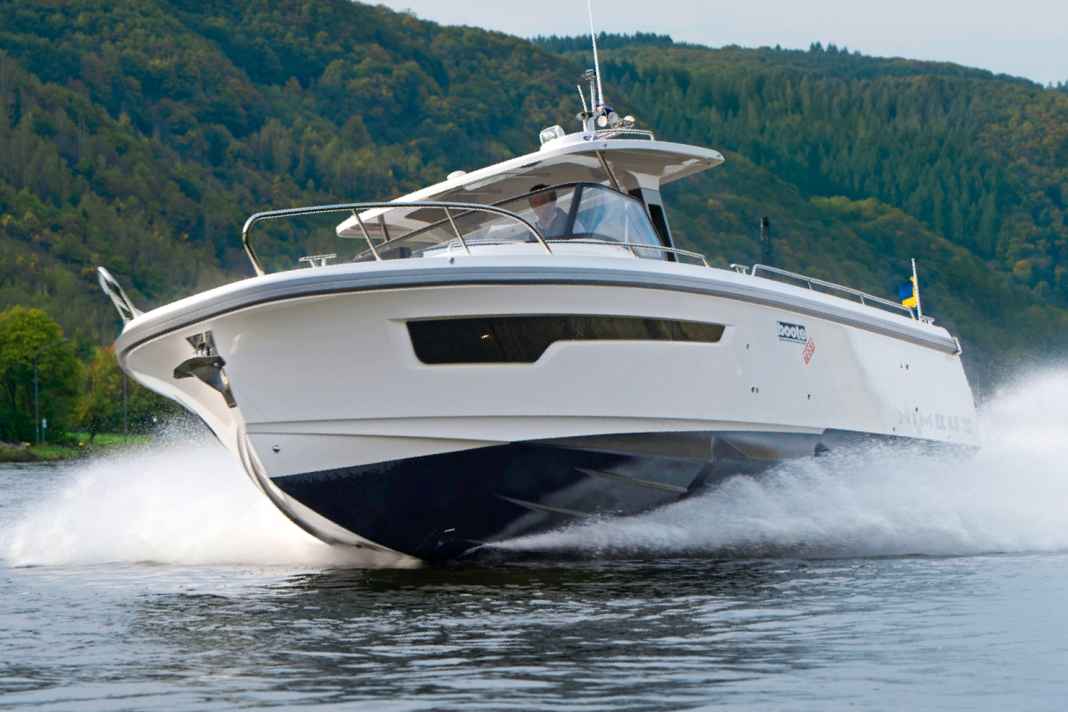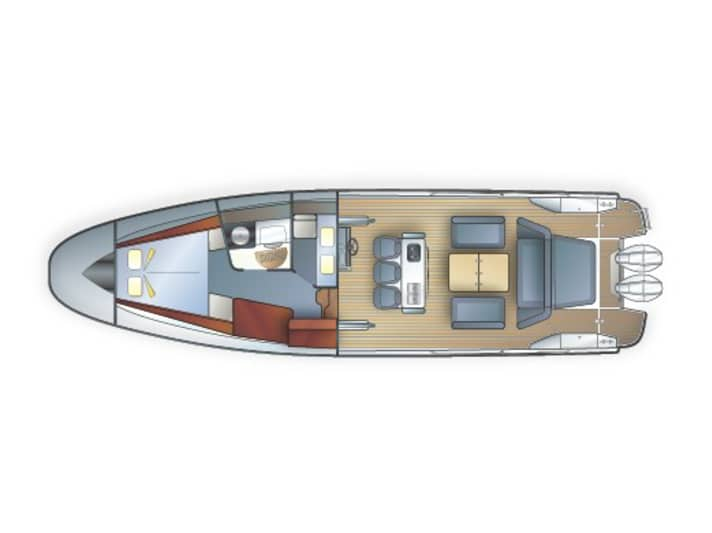





Nimbus has done a lot of development work in recent years: They have launched three commuter models between just under 8.00 m and almost 12.50 m, three tenders of the same length and a day cruiser model (Weekender 9, just under 9.50 m). Our test boat, the Tender 11 (abbreviated T11), is from the largest series. The boat is powered by two 400 hp Mercury outboards - a diesel inboard version is also planned. Our two engines had a joystick system and the associated autopilot and skyhook as additional equipment. The latter always keeps the boat in the same position with the help of the outboards. For easy manoeuvring, however, there is not only the joystick system, but also a bow thruster.
Smooth transition from displacement to gliding travel
At slow speeds - around 6.5 knots - the Nimbus remains stable on course and, in purely mathematical terms, manages a non-stop journey of 334 nm plus 15% reserve. If you push the levers further forwards, the transition from displacement to planing begins at around 2000 rpm. The Tender 11 reaches high speed without any noticeable obstruction to visibility. The automatic zip-wake trim system helps of course, but even without it, the Nimbus manages the transition without any problems. The outboard-powered boat and crew travels economically at between 24 kn and 30.4 kn, with a good 3.5 l/sm running through the fuel lines and a range of a good 200 nm, which is decent for this type of boat. The noise level in this situation is between a moderate 82 and 83 dB/A. At full throttle, we measured 88 dB/A and achieved a top speed of 45 knots with a fuel consumption of 5.15 l/sm, which in turn still results in a range of 140 nm.
On the fast slalom course, the hull swings easily from one side to the other. When the rudder is torn, the Nimbus Tender 11 always sets in with the stern in a controlled manner without swinging. In fast, tight bends, the Nimbus pulls in sportily until the propellers catch air. When steering straight ahead with precise control, the propellers regain their power and the test boat immediately accelerates again.
A highlight: Adjustable seats for individualised driving comfort
Our test Nimbus is driven from a well-equipped control station. Here, two monitors show where the boat is travelling and the operating status of the two outboards. The controls are electro-hydraulic, the gearstick is electronic, and both are easy to operate. I particularly liked the adjustable three seats, which are arranged in front of the driving position. They have sporty upholstery, their seat and backrest surfaces are moulded and provide good support. The car pool sits behind a safety glass windscreen with defroster nozzles, two windscreen wipers and a washer system. There is a gap between the windscreen and the roof, which allows cool air to flow through in summer and can be closed with a foil window in the off-season to keep out the fresh wind.
A fully equipped galley is located behind the three-seater bench on the test boat. This in turn is adjoined by a very variable seat/lounger unit with a folding table. This means that many people can really find their favourite places here. The bow cabin has a normal double berth, while guests in the underfloor cabin have to make do with around 1.98 metres x 1.24 metres. In addition to the aft berth, two access points (drawback: no doors) lead to the split bathing platform with stern shower and wide, long bathing ladder. Another great open-air area is located on the foredeck. Here, too, high-quality upholstery (part of the so-called X-Edition) guarantees a feeling of well-being. Further highlights: The outer surfaces can be quickly and easily covered with biminis, and the steps are covered with a soft surface.
Below deck there is a V-berth that offers a comfortable sleeping space for two people. The space in the underfloor cabin is not as generous, but is perfectly acceptable for children and occasional guests. The wet room is equipped with everything you need.
As we have often seen with Nimbus, the technology is exemplary. Be it the complete tank system with shut-off valves and external filter or the complete bilge system.
Our test judgement of the Nimbus Tender 11
DRIVING & MANOEUVRING
+ Safe driving characteristics
+ Easy manoeuvring with the joystick system
PROCESSING & TECHNOLOGY
+ High-quality upholstered furniture and fittings
+ Cleanly installed technology
SAFETY
+ Fire extinguishers and bilge pumps
- Missing rear doors
COMFORT ON BOARD
+ Large variable seating and reclining areas in the bow and cockpit
+ Pleasantly soft floor covering
Conclusion
The Nimbus Tender 11 has good handling characteristics and is easy to manoeuvre with the joystick system and thruster. The deck area with its large cockpit and variable furniture is particularly appealing, offering comfort on tours and at anchor, just like the foredeck. Longer trips are also possible with two double berths and a wet room.
Technical data Nimbus Tender 11
The boat
- Shipyard: Nimbus/SE
- Type: Tender 11
- CE category: B/11 persons
- Hull and deck: Plastic
- Length over everything: 12,40 m
- Width: 3,46 m
- Weight (with 350 hp outboard): 5600 kg
- Depth: 0,90 m
- Clearance height: 3,75 m
- Fuel tank: 850 l
- Water tank: 135 l
- Holding tank: 80 l
- Cabins: 2
- Berths: 4
- possible motorisation: Outboard engines with 2x 221 kW (300 hp) to 2x 294 kW (400 hp)
- Test motorisation: 2x Mercury F400 Verado L6 294 kW (400 hp) each
- Base price (with roof and test engine): 444.060 €
- Distribution (test boat)Boote Polch, Zum Hafen 18, 56841 Traben Trabach, www.bootepolch.de

The motor
- Manufacturer: Mercury
- Type: F400 Verado L6
- Performance: 294 kW (400 hp)
- Full load speed range: 6200-6800 rpm
- Cylinder: 6 in series
- cubic capacity: 2600 cc
- Fuel: Petrol
- Cooling: Water/single circle
- Gear ratio: 1,75 : 1
- Test propeller: Revolution 4 Sheet 17

